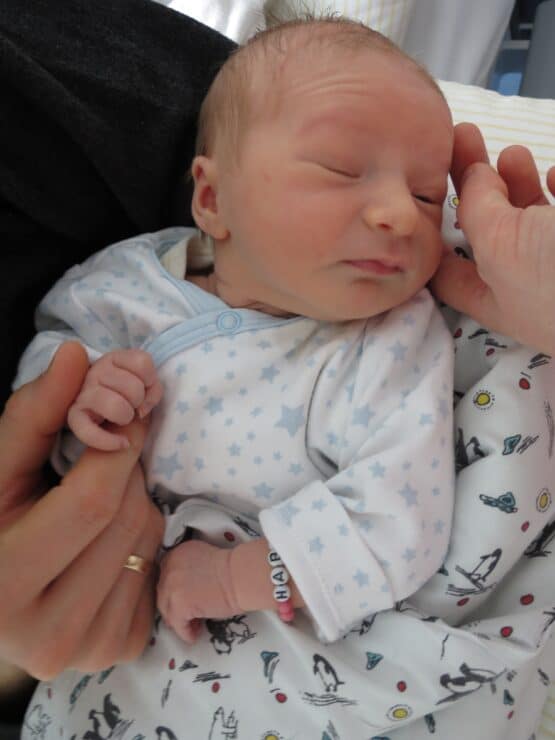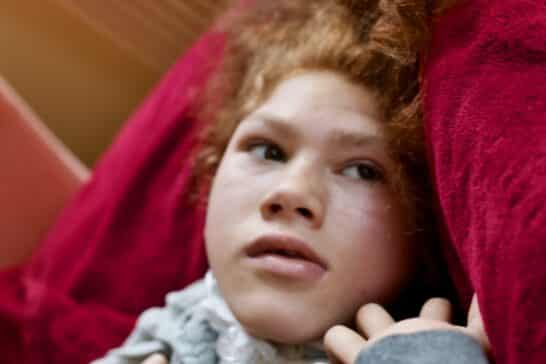In most cases, the unborn child is not diagnosed with PCH2 during pregnancy. However, it has been possible to diagnose the condition before birth using genetic testing for several years now. However, as it is a very rare disease, this test is only carried out in families with a known increased risk. This means that there is either a sibling with PCH2 or the mutation has been identified within the family.
Pregnancy
There are usually no obvious disease-specific abnormalities during pregnancy with a child with PCH2.
Abnormalities such as polyhydramnios (excessive amniotic fluid), tremors of the child in the womb, or a reduced head circumference, which are associated with PCH in literature, occur in around half of all pregnancies.
However, almost half of all pregnancies with a child with PCH2 progress without significant complications. Sonographic examinations of the brain, which are usually carried out in the second half of pregnancy, only reveal abnormalities such as microcephaly (reduced head circumference) in rare cases.
Birth
Children with PCH2 do not show any unusual patterns in terms of prematurity or the rate of caesarean sections. Most children are born as full-term babies, and the caesarean section rate is not above the average for all births.
Neonatal Period
At birth, children with PCH2 have a normal weight and length.
The head circumference is mostly within the normal range, although microcephaly (reduced head circumference) may already be present at birth.
Although the indices of neonatal wellbeing, such as the APGAR score and umbilical cord arterial pH measurement, are also normal in children with PCH2, many require transfer to a pediatric clinic for further treatment within the first few days of life. The main reasons for this are breathing problems, feeding difficulties or general adaptation disorders.
Within the first month of life (neonatal period), almost all affected children show typical PCH2 symptoms such as feeding difficulties, increased restlessness or abnormal muscle tone, sleepiness or breathing problems.
In the German-speaking parent forum, some parents report that they were questioned about drug use during pregnancy due to the above-mentioned symptoms in their newborns. Drug or cigarette use during pregnancy can cause withdrawal symptoms in newborns that resemble the symptoms of a child with PCH2. Since withdrawal symptoms are a more common diagnosis in everyday clinical practice than PCH2, the attending physicians may inquire about substance use during pregnancy. However, the underlying causes of these symptoms differ fundamentally.
Scientific Background
Data from the literature
- Steinlin et al. (2007) reported on 14 ultrasound examinations in the second half of pregnancy, all of which appeared normal.
- Graham et al. (2010) concluded that, based on current knowledge, a reliable diagnosis cannot be made using prenatal ultrasound.
- In Steinlin et al. (2007), 2 out of 21 children were born preterm. 3 of 21 deliveries were performed by caesarean section.
- Namavar et al. (2011) reported on 11 preterm infants among a study of 63 children.
- The publications by Steinlin et al. (2007), Barth et al. (2007 and 2008) and Namavar et al. (2011) show that head circumference may already be reduced at birth in individual cases, although not invariably within the pathological range, and that microcephaly develops progressively in all affected children during early childhood.
- Abnormalities during the neonatal period have been reported in multiple publications. Steinlin et al. (2007) and Namavar et al. (2011) report on children requiring ventilatory support, while Barth et al. (2007) and Steinlin et al. (2007) found abnormalities of muscle tone and described seizure onset within the first weeks of life.
Natural History Study from 2014
Pregnancy
Fourteen of the 33 pregnancies were without notable findings. In 19 pregnancies, mostly nonspecific abnormalities were observed, such as intrauterine growth restriction (3 cases), increased (7 cases) or reduced fetal movements (2 cases), or gestational diabetes (2 cases). Specific abnormalities, including microcephaly (4 cases), polyhydramnios (excess amniotic fluid, 4 cases), or fetal tremor (6 cases), occurred in a total of 10 pregnancies (multiple findings per pregnancy were possible). In the 4 cases in which microcephaly was diagnosed prenatally, the diagnosis was made between gestational weeks 32 and 35. In a total of 29 pregnancies, intrauterine ultrasound examinations were performed as part of trimester screening; in 8 cases, additional specialized ultrasound imaging was carried out for detailed assessment of the brain and cerebellum. The indications were either abnormalities detected during pregnancy or, in 4 cases, the presence of PCH2 in an older sibling. Microcephaly was identified in only the 4 cases mentioned above; in one additional case, fluid accumulation in the cerebellum was found. In one pregnancy, a fetal brain MRI was performed at 21 weeks pregnant, which revealed no pathological findings.
Birth
The children were born on average between the 39th and 40th gestation week; 2 were preterm infants delivered at 36 weeks. In 9 cases, delivery was by caesarean section. The mean birth weight was 3378.8 g, the mean birth length 51.4 cm, and the mean head circumference 33.5 cm. All values were within the normal range, with head circumference at the lower end of normal. Although pH values and Apgar scores were generally within the normal range, 20 infants required postnatal care in a pediatric unit. The main reasons were breathing problems, feeding difficulties, and abnormal movement patterns such as myoclonus and hypertonia.
Neonatal Period
Within the first month of life, 32 of the 33 infants showed abnormalities. In descending order of frequency, these included feeding difficulties, irritability or increased sleepiness, muscular hypertonia, and prolonged or excessive crying. In 13 cases, feeding problems necessitated temporary nasogastric tube feeding during the neonatal period. Two infants experienced seizures within the neonatal period.
Natural History Study from 2023
Pregnancy and Birth
This study examined pregnancies and births of the 33 children from the Tübingen study of 2014 and the 32 children from the Freiburg study, yielding data from 65 pregnancies and births in total. The pregnancies lasted an average of 39.6 weeks. There were no multiple births. A total of three children were born preterm, which corresponds to a preterm birth rate of 4.6%. The mean birth weight of the full-term babies was 3,457.5 g, the mean birth length was 51.7 cm, and the mean head circumference was 33.9 cm. Apgar scores taken at five and ten minutes were 9-10 in most cases (44/60 after 5 minutes and 54/60 after 10 minutes). The mean umbilical artery pH was 7.28.
Neonatal Period
Data was available for 53 infants. Of these, 39 required inpatient treatment in a pediatric unit during the first month of life. Of these, 36 were transferred to a pediatric clinic within 72 hours after birth. A nasogastric tube was required in 22 cases (in 13 cases, tube feeding was still required after discharge from the hospital), and 15 children were discharged home with a portable vital signs monitor. Fourteen children required oxygen (in two cases also after hospital discharge), four children required ventilation. Antibiotic therapy was administered in 11 cases.
The most common problems encountered in the neonatal period, in descending order, were feeding difficulties, restlessness/irritability, muscular hypertonia, sleepiness, abnormal movement patterns, excessive crying, muscular hypotonia, apneas, excessive weight loss, and (5 cases) epileptic seizures.
This entry was written to the best of our knowledge based on the reported experiences of parents of affected children. In addition, currently available data from the 2014 and 2023 Natural History Studies of PCH2 and from general medical literature has been included. It is not a substitute for consulting a medical professional. PCH2cure assumes no liability in this respect.
- Barth P G, Aronica E, de Vries L, Nikkels P G, Scheper W, Hoozemans J J, Poll-The B T, Troost D (2007) Pontocerebellar hypoplasia type 2: a neuropathological update. Acta Neuropathol 114(4): 373-386
- Barth P G, Ryan M M, Webster R I, Aronica E, Kan A, Ramkema M, Jardine P, Poll-The B T (2008) Rhabdomyolysis in pontocerebellar hypoplasia type 2 (PCH-2). Neuromuscul Disord 18(1):52-58
- Graham J M, Jr., Spencer A H, Grinberg I, Niesen C E, Platt L D, Maya M, Namavar Y, Baas F, Dobyns W B (2010) Molecular and neuroimaging findings in pontocerebellar hypoplasia type 2 (PCH2): is prenatal diagnosis possible? Am J Med Genet A 152A(9): 2268-2276
- Namavar Y, Barth P G, Kasher P R, van Ruissen F, Brockmann K, Bernert G, Writzl K, Ventura K, Cheng E Y, Ferriero D M, Basel-Vanagaite L, Eggens V R, Krägeloh-Mann I, De Meirleir L, King M, Graham J M, Jr., von Moers A, Knoers N, Sztriha L, Korinthenberg R, Dobyns W B, Baas F, Poll-The B T (2011) Clinical, neuroradiological and genetic findings in pontocerebellar hypoplasia. Brain 134(Pt 1): 143-156
- Steinlin M, Klein A, Haas-Lude K, Zafeiriou D, Strozzi S, Müller T, Gubser-Mercati D, Schmitt Mechelke T, Krägeloh-Mann I, Boltshauser E (2007) Pontocerebellar hypoplasia type 2: variability in clinical and imaging findings. Eur J Paediatr Neurol 11 (3): 146-152
- 2014 Study: Frölich S. Natürlicher Verlauf der Pontocerebellären Hypoplasie Typ 2 [Dissertation to Acquire the Academic Degree Doctor of Medicine] Tübingen: Eberhard-Karls-Universität; 2014
- 2023 Study: Kuhn A L. Gastrointestinale Symptome, Ernährung und Gedeihen bei Pontocerebellärer Hypoplasie Typ 2 A [Dissertation to Acquire the Academic Degree Doctor of Medicine] Freiburg im Breisgau: Albert-Ludwigs-Universität; 2023


